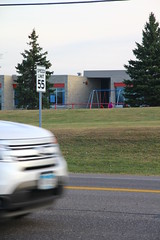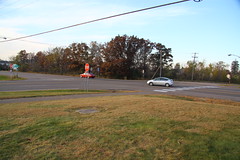Covering rail projects along the Twin Cities – Milwaukee – Chicago Corridor, and delving into the history of the Hiawathas, Zephyrs, and 400s which raced through this region in excess of 100 mph in the 1930s, '40s, and '50s.
Thursday, November 24, 2011
A mile away from Bailey Elementary, a possible solution
When I first came across this image of a roundabout with dedicated tunnels for bikes and pedestrians, I thought I had somehow wandered onto David Hembrow's blog about cycling in the Netherlands, but no, it turns out this is an image of an American roundabout. A Minnesotan roundabout. A Woodburian roundabout.
A roundabout in Woodbury? With two lanes, bike paths, and tunnels? Yep.
A few weeks ago, Mike Spack linked to an online presentation by Joe Gustafson of Washington County Public Works that covered the project. It's the first fully two-lane roundabout in the state, so the county used it to experiment a bit and collected extra data about its performance—hence the reason for the presentation.
However, the main thing that jumped at me was the roundabout's location: It's at the intersection of Radio Drive and Bailey Road. You might remember Bailey Road from news stories earlier this year about Gordon Bailey Elementary School. It became a cause célèbre for Minnesota urbanists after it was reported that of the 620 students, none of them walked or rode bicycles to school.
Now, I don't want to sound like a ratchety old fart talking about walking in eight-foot snowdrifts uphill both ways, but I did grow up in the southeastern Minnesota town of Byron, where kids within the city limits were (at the time) required to make their own way to and from school—whether it was by walking, biking, or getting a ride from a family member. I mostly walked, but did ride my bike or get rides on occasion. One of the main roads to my elementary school had a speed limit of 15 miles per hour, while others were normally 30 but restricted to 20 mph when students were present.
Because I grew up with a school on a slow street, I'm always amazed to see schools such as Bailey placed next to 55-mph suburban arterials. Unfortunately, it has been a common practice in the United States for the past few decades.
Roads such as this can be deadly for students. For me, this reality came into stark relief when I was in high school—a student in nearby Kasson was killed crossing the 40-mph Mantorville Avenue (Minnesota State Highway 57) near that city's high school. He was hit fast enough to be lifted out of his shoes—the mental image of empty sneakers marking a crash victim's last footsteps is something that always sticks with me.
Due to my own experiences, I'm inclined to think that parents and kids feel unsafe crossing Bailey Road, and that's why every student gets driven or bused to school. In the original reporting on the subject, parents gave a variety of reasons for driving their children, but the school's location still sticks out like a sore thumb.
So, how do you make this road—out on the edge of the urban boundary—feel safe? Ideally, I'd like to see schools located in town centers, like the elementary I grew up with. Built up near the edge of streets that are designed to be slow, even if the slow area only lasts a block or so.
But here, we're dealing with an established facility that's on roads that are made for high speed. Reducing the speed limit might help, but a road lined on one side by farmland is unlikely to be driven slowly. Wide open spaces encourage wide open throttles, so a reduced speed limit would likely be ignored.
In this case, it seems the best option is to completely separate pedestrian traffic from the road, allowing people to get from one side to the other without having to wait for cars to pass or stop.
Tunnels or bridges across the road are the way to accomplish that. Expensive solutions, but worth the money because they will save lives. Certainly criticism would follow any such proposals, but critics should also recognize that they are usually remedies to problems that never should have existed in the first place. Unwalkable locations bring latent costs with them, and building special grade-separated walkways just makes those hidden costs visible.
Schools should be built in walkable places, period. They are engines of community, and should be treated as such.
Subscribe to:
Post Comments (Atom)




Do you have any direct on-street experience with that roundabout? I'm asking because, while I obviously have none, from the photos it doesn't look very pedestrian-friendly. The sidewalks are not framed by any street wall, the environment looks like high-speed arterial hell, and the underpass is probably unpleasant to walk through. In general, my experience with underpasses in e.g. Singapore is that cities build them as poor substitutes for making streets crossable at-grade.
ReplyDeleteThe cost issue makes this just more infuriating. This underpass is coming out of the bike/ped budget, when it should come out of the road budget, as it's really a road project enabling cars to maintain their high speed near a school. I'm reminded by how in the US, road/rail grade separations always come out of the rail budget even if the railroad was there first.
Mulad, I drove through your town yesterday morning. Or maybe you could say I drove along U.S. 14 (from MN56 to U.S. 52) so not through the town. There sure is a lot of development out near the highway. I'm guessing U.S> 14 once went through the heart of Byron along with MN 57?
ReplyDeleteMatt: While Byron was a pretty walkable place when I was a kid, things have changed, and the town has kind of flipped itself inside-out. That's going to have to be the subject of another blog post, however.
ReplyDeleteAs far as I know, MN-57 has always ended in Kasson -- it's basically a connector from U.S. 14 to U.S. 52 up around Hader. Byron has only had to deal with county highways. Back before I was born, U.S. 14 apparently ran along County Highway 34/Country Club Road, which leads to 2nd Street South in Rochester (that route was always called "Old 14" by my parents).
Alon: I've only spent time in the area once. Several photos are in my Flickr stream preceding my walk-around near the school. Take a look at my Woodbury set. I agree that it's arterial hell, but it feels better to me than what would have otherwise been built with a regular stop-light intersection.
The county engineer claimed that they had planned to build a pedestrian underpass anyway just because the geography was conducive to it. They also seemed to say that a lot of pedestrian traffic was expected. There's a massive youth sports complex to the southeast of the roundabout, which aligns with old concerns I've had about how Americans seem to value sports over education...
I don't know whether or not this particular project ended up being built with bike/ped money (though I suppose if the source of funds is available, they'll use it).
Oops, I also meant to say that U.S. 14 used to run along what is now the Frontage Road from County 34 west toward Kasson.
ReplyDeleteIt's hard to say if American motorists' disregard for pedestrians is a chicken-and-egg problem. It seems likely that in the Netherlands this roundabout would have crossings at grade, but is that because drivers there are used to at-grade crossings? To my knowledge, there has never been any systematic attempt to enforce or even raise awareness of the pedestrian priority law (passed in the mid-90s in MN I think) and the result is that most drivers don't even know that they're required to yield at a crosswalk. That leads to expensive grade separations and the feeling that it's unsafe to walk.
ReplyDeleteAnother important difference between driving in the USA and in the Netherlands is speed. The speed limits aren't that different really - rural or semi-rural roads are commonly posted at 70 kph, just a bit less than here. But what I've noticed is that because of road design (sustained four-lane segments are uncommon), drivers there are used to slowing frequently. That not only makes them more likely to drive at or below the limit (instead of above the limit, as the murderous Mantorville motorist was likely doing) but also more likely to stop for peds maybe?
I work in Woodbury and pass through the roundabout intersection and four way stop nearly every day. The area surrounding the roundabout is indeed currently fairly pedestrian unfriendly. There are plans to create a mixed use urban village on the last open corner of Bailey/Radio. But Woodbury's other attempt at mixed use was bad, so I doubt it will be configured towards either road.
ReplyDeleteAs far as them building a roundabout at Bailey/Radio because of America's fascination with sports, you left out there is a new high school with a larger student population than the elementary school. Also, Radio has heavier traffic than Woodlane, making an upgrade to either a stoplight or roundabout necessary. (Road projects come slowly in Washington County) Talk about grasping for straws. I'm gonna take a wild guess and say you don't want the Vikings Stadium built with any public money.
I know they are trying to widen Bailey through that entire area to four lanes. I'm guessing the four way stop at Bailey/Woodlane will end when the land is acquired. There may even be an attempt to lower speeds (even with four lanes).